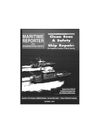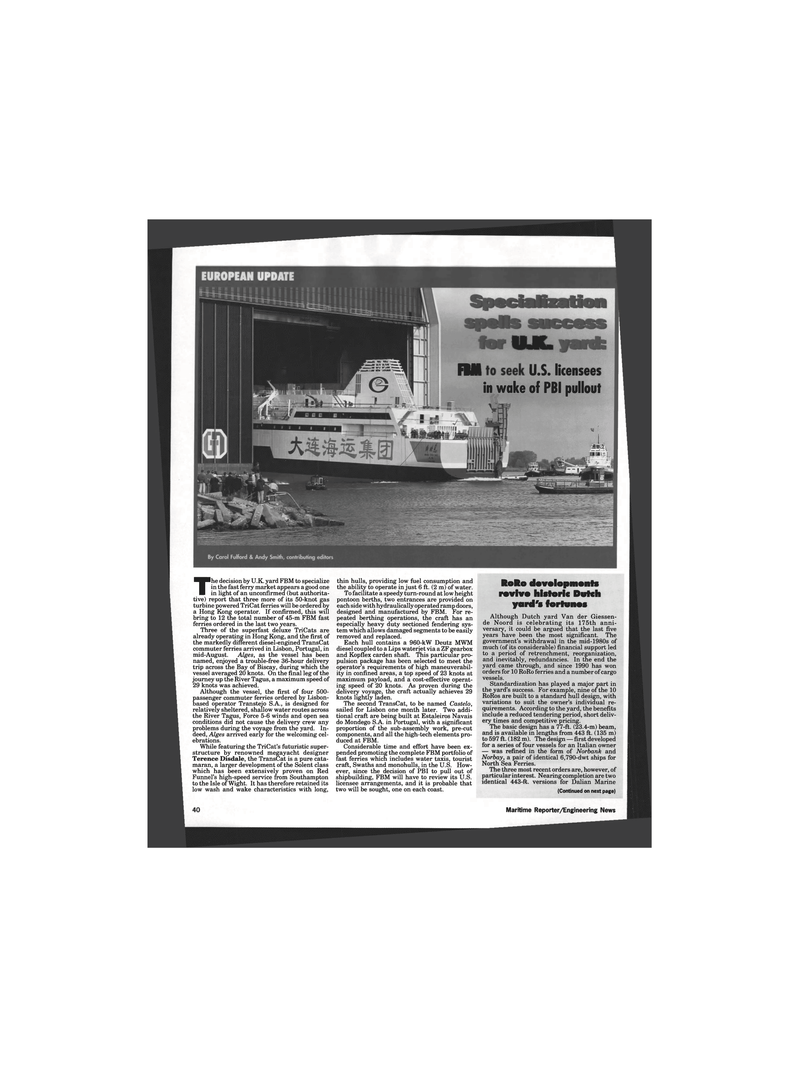
Page 38: of Maritime Reporter Magazine (October 1995)
Read this page in Pdf, Flash or Html5 edition of October 1995 Maritime Reporter Magazine
FBM
IAJK.
U.S. licensees in wake of PBI pullout
The decision by U.K. yard FBM to specialize in the fast ferry market appears a good one in light of an unconfirmed (but authorita- tive) report that three more of its 50-knot gas turbine powered TriCat ferries will be ordered by a Hong Kong operator. If confirmed, this will bring to 12 the total number of 45-m FBM fast ferries ordered in the last two years.
Three of the superfast deluxe TriCats are already operating in Hong Kong, and the first of the markedly different diesel-engined TransCat commuter ferries arrived in Lisbon, Portugal, in mid-August. Alges, as the vessel has been named, enjoyed a trouble-free 36-hour delivery trip across the Bay of Biscay, during which the vessel averaged 20 knots. On the final leg of the journey up the River Tagus, a maximum speed of 29 knots was achieved.
Although the vessel, the first of four 500- passenger commuter ferries ordered by Lisbon- based operator Transtejo S.A., is designed for relatively sheltered, shallow water routes across the River Tagus, Force 5-6 winds and open sea conditions did not cause the delivery crew any problems during the voyage from the yard. In- deed, Alges arrived early for the welcoming cel- ebrations.
While featuring the TriCat's futuristic super- structure by renowned megayacht designer
Terence Disdale, the TransCat is a pure cata- maran, a larger development of the Solent class which has been extensively proven on Red
Funnel's high-speed service from Southampton to the Isle of Wight. It has therefore retained its low wash and wake characteristics with long, thin hulls, providing low fuel consumption and the ability to operate in just 6 ft. (2 m) of water.
To facilitate a speedy turn-round at low height pontoon berths, two entrances are provided on each side with hydraulically operated ramp doors, designed and manufactured by FBM. For re- peated berthing operations, the craft has an especially heavy duty sectioned fendering sys- tem which allows damaged segments to be easily removed and replaced.
Each hull contains a 960-kW Deutz MWM diesel coupled to a Lips waterjet via a ZF gearbox and Kopflex carden shaft. This particular pro- pulsion package has been selected to meet the operator's requirements of high maneuverabil- ity in confined areas, a top speed of 23 knots at maximum payload, and a cost-effective operat- ing speed of 20 knots. As proven during the delivery voyage, the craft actually achieves 29 knots lightly laden.
The second TransCat, to be named Castelo, sailed for Lisbon one month later. Two addi- tional craft are being built at Estaleiros Navais do Mondego S.A. in Portugal, with a significant proportion of the sub-assembly work, pre-cut components, and all the high-tech elements pro- duced at FBM.
Considerable time and effort have been ex- pended promoting the complete FBM portfolio of fast ferries which includes water taxis, tourist craft, Swaths and monohulls, in the U.S. How- ever, since the decision of PBI to pull out of shipbuilding, FBM will have to review its U.S. licensee arrangements, and it is probable that two will be sought, one on each coast.
RoRo developments revive historic Dutch yard's fortunes
Although Dutch yard Van der Giessen- de Noord is celebrating its 175th anni- versary, it could be argued that the last five years have been the most significant. The government's withdrawal in the mid-1980s of much (of its considerable) financial support led to a period of retrenchment, reorganization, and inevitably, redundancies. In the end the yard came through, and since 1990 has won orders for 10 RoRo ferries and a number of cargo vessels.
Standardization has played a major part in the yard's success. For example, nine of the 10
RoRos are built to a standard hull design, with variations to suit the owner's individual re- quirements. According to the yard, the benefits include a reduced tendering period, short deliv- ery times and competitive pricing.
The basic design has a 77-ft. (23.4-m) beam, and is available in lengths from 443 ft. (135 m) to 597 ft. (182 m). The design — first developed for a series of four vessels for an Italian owner — was refined in the form of Norbank and
Norbay, a pair of identical 6,790-dwt ships for
North Sea Ferries.
The three most recent orders are, however, of particular interest. Nearing completion are two identical 443-ft. versions for Dalian Marine (Continued on next page) 40 Maritime Reporter/Engineering News

 37
37

 39
39
